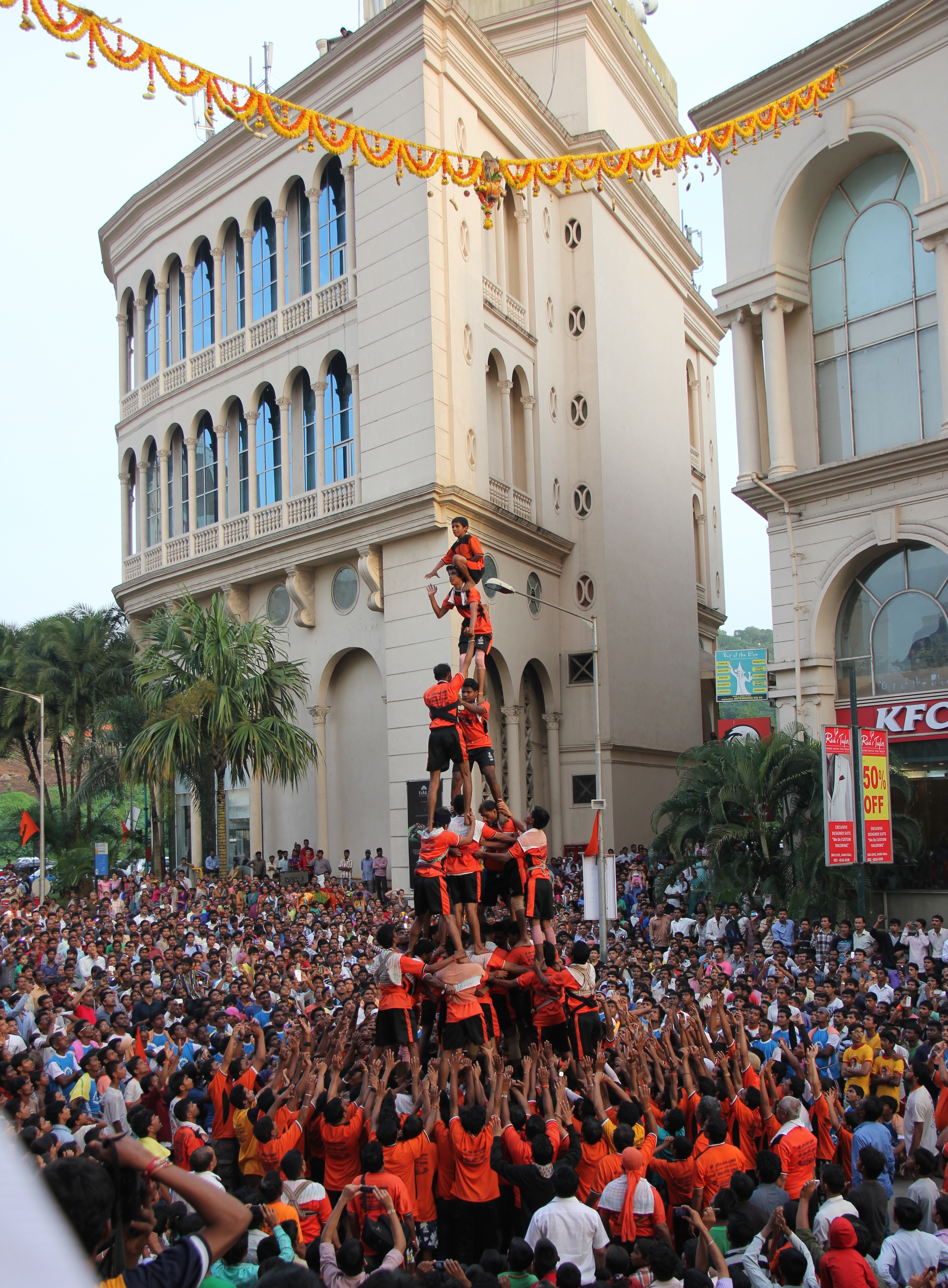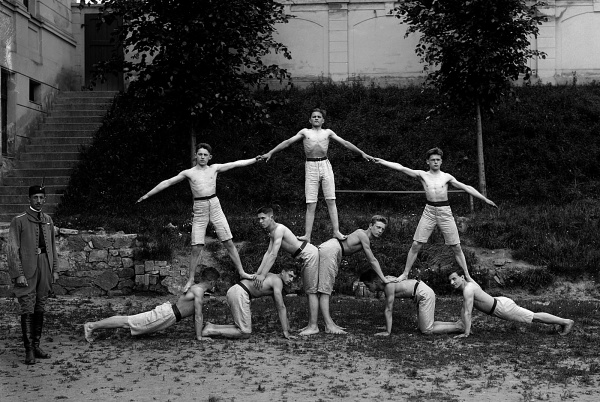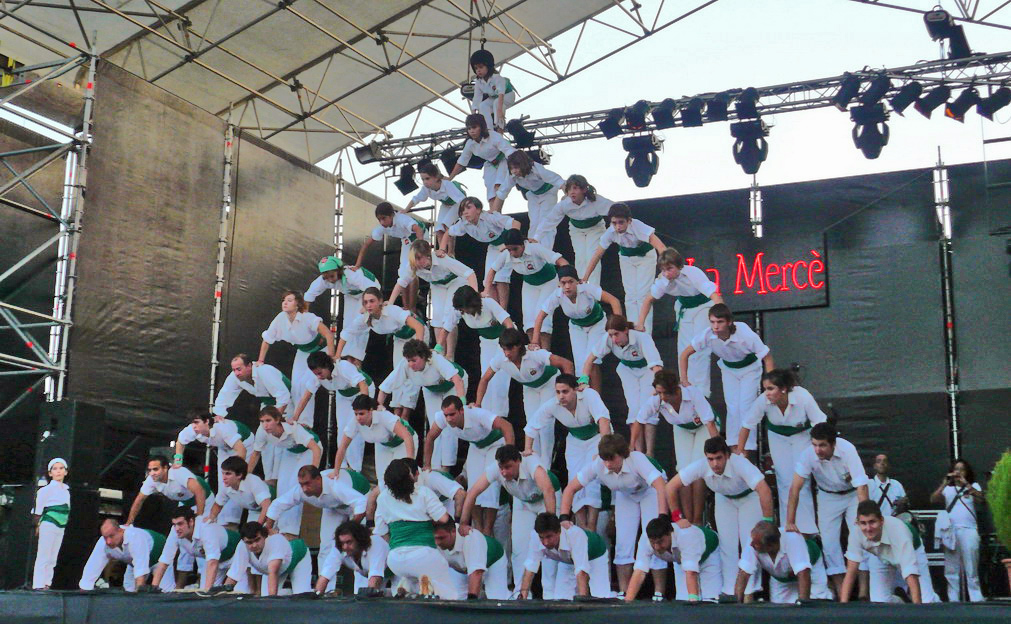Human pyramid on:
[Wikipedia]
[Google]
[Amazon]

 A human pyramid is an
A human pyramid is an
 *
*

Human pyramids at school sports days spark safety concerns
the japan times SEP 25, 2014
Gymnastic Formation-related Injury to Children in Physical Education
(※PDF) Journal of Nippon Medical School. Accepted, September 27, 2015
A scientific investigation of risk in large gymnastic formations
※PDF) Yutaka Nishiyama January-15 2017 NAID:120005972587
 A human pyramid is an
A human pyramid is an acrobatic
Acrobatics () is the performance of human feats of balance, agility, and motor coordination. Acrobatic skills are used in performing arts, sporting events, and martial arts. Extensive use of acrobatic skills are most often performed in acro ...
formation of three or more people in which two or more people support a tier of higher people, who in turn may support other, higher tiers of people. People above the bottom tier may kneel or stand on the shoulders, backs or thighs of the people below them. Typically, the number of people in each tier is one greater than the tier immediately above it, resulting in a triangular structure reminiscent of the formation's namesake.
For practical reasons, lighter people are often positioned higher in the formation and stronger, heavier people are located closer to the base. Human pyramids are performed in various activities, including cheerleading and in circus
A circus is a company of performers who put on diverse entertainment shows that may include clowns, acrobats, trained animals, trapeze acts, musicians, dancers, hoopers, tightrope walkers, jugglers, magicians, ventriloquists, and unicyclis ...
acrobatics.
Traditions involving human pyramids
China
* Human pyramids are often formed to reach for the bun during the Chinese Bun Festival.Czech Republic
 *
* Sokol
The Sokol movement (, ''falcon'') is an all-age gymnastics organization first founded in Prague in the Czech region of Austria-Hungary in 1862 by Miroslav Tyrš and Jindřich Fügner. It was based upon the principle of " a strong mind in a ...
is a youth sport movement and gymnastics organization founded in Czech region of Austria-Hungary, Prague, in 1862. It was primarily a fitness training center for the nation. The movement also spread across other Slavic regions. Some of the Sokol exercises included human pyramids.
India
* During theHindu
Hindus (; ) are people who religiously adhere to Hinduism. Jeffery D. Long (2007), A Vision for Hinduism, IB Tauris, , pages 35–37 Historically, the term has also been used as a geographical, cultural, and later religious identifier for ...
festival Krishna Janmashtami
Krishna Janmashtami , also known simply as Krishnashtami, Janmashtami, or Gokulashtami, is an annual Hindu festival that celebrates the birth of Krishna, the eighth avatar of Vishnu. According to the Hindu lunisolar calendar, it is observed ...
in Maharashtra
Maharashtra (; , abbr. MH or Maha) is a state in the western peninsular region of India occupying a substantial portion of the Deccan Plateau. Maharashtra is the second-most populous state in India and the second-most populous country subdi ...
, young men form human pyramids to reach pots filled with curd and butter and suspended high above the ground as part of the ''Dahi Handi'' ritual.
Spain
*Algemesí
Algemesí () is a municipality in the ''comarca'' of Ribera Alta in the Valencian Community, Spain.
The town of Algemesí is one of the major centres for the production of citruses in Spain, and several cooperatives are based there. This is due ...
holds a Human Pyramid Festival annually on September 8 as a component of the Fiesta de La Virgen de la Salud (Virgin of Good Health). The muixeranga, or acrobats, form the human towers.
*Catalonia
Catalonia (; ca, Catalunya ; Aranese Occitan: ''Catalonha'' ; es, Cataluña ) is an autonomous community of Spain, designated as a '' nationality'' by its Statute of Autonomy.
Most of the territory (except the Val d'Aran) lies on the no ...
: The "castellers" of Catalonia
Catalonia (; ca, Catalunya ; Aranese Occitan: ''Catalonha'' ; es, Cataluña ) is an autonomous community of Spain, designated as a '' nationality'' by its Statute of Autonomy.
Most of the territory (except the Val d'Aran) lies on the no ...
form human pyramids, named castell
A ''castell'' () is a human tower built traditionally at festivals in Catalonia, the Balearic islands and the Valencian Community.
At these festivals, several ''colles castelleres'' (teams that build towers) attempt to build and dismantle a ...
s ("castles"), up to ten men high. In Catalonia, severals statues commemorate this old tradition. In Tarragona
Tarragona (, ; Phoenician: ''Tarqon''; la, Tarraco) is a port city located in northeast Spain on the Costa Daurada by the Mediterranean Sea. Founded before the fifth century BC, it is the capital of the Province of Tarragona, and part of Tarr ...
the castellers form human towers during the Santa Tecla Festival in September and during the Sant Magi festival, held annually in mid-August.
: The Falcons
Falcons () are birds of prey in the genus ''Falco'', which includes about 40 species. Falcons are widely distributed on all continents of the world except Antarctica, though closely related raptors did occur there in the Eocene.
Adult falcons ...
are traditional teams in Catalonia who build human pyramids and towers. They follow different rules from the ones of the castells.

United States
* It is used in bonding, e.g. as part of a North American collegefraternity
A fraternity (from Latin ''frater'': "brother"; whence, " brotherhood") or fraternal organization is an organization, society, club or fraternal order traditionally of men associated together for various religious or secular aims. Fraternit ...
hazing
Hazing (American English), initiation, beasting (British English), bastardisation (Australian English), ragging (South Asian English) or deposition refers to any activity expected of someone in joining or participating in a group that humiliates, ...
ritual, or in a variation called a ''spanking pyramid'', suitable as a collective punishment
Collective punishment is a punishment or sanction imposed on a group for acts allegedly perpetrated by a member of that group, which could be an ethnic or political group, or just the family, friends and neighbors of the perpetrator. Because ind ...
, in which the pledges, often divested, are paddled on the conveniently protruded posterior.
*Boy Scouts
Boy Scouts may refer to:
* Boy Scout, a participant in the Boy Scout Movement.
* Scouting, also known as the Boy Scout Movement.
* An organisation in the Scouting Movement, although many of these organizations also have female members. There are t ...
and Girl Scouts may hold competitions where the patrol that builds a human pyramid using all the scouts in their patrol the fastest, wins.
* University performance groups use human pyramids as large-scale acrobalance
Acrobalance is a floor-based acrobatic art that involves balances, lifts and creating shapes performed in pairs or groups.
A performer on the ground doing the lifting and supporting in an acrobalance formation is often called the ''base'', while ...
. The University of Maryland Gymkana Troupe keeps a tradition alive by building a series of pyramids during every one of their large shows. The Washington Adventist University Acro-Airs create 3-person high pyramids while combining cheer-based skills and tumbling passes.
Veneto
*In Venice until the eighteenth century there were human towers formed by Castellani and Nicolotti, inhabitants of different parts of Venice. Their human towers, maximum of 8 levels of men, were called Forze d'Ercole. At the top there was a child, usually called the Cimiereto.Cheerleading
Cheerleader
Cheerleading is an activity in which the participants (called cheerleaders) cheer for their team as a form of encouragement. It can range from chanting slogans to intense physical activity. It can be performed to motivate sports teams, to ente ...
s may perform human pyramids with more difficult stunt
A stunt is an unusual and difficult physical feat or an act requiring a special skill, performed for artistic purposes usually on television, theaters, or cinema. Stunts are a feature of many action films. Before computer generated imagery sp ...
sequences and gymnastics
Gymnastics is a type of sport that includes physical exercises requiring balance, strength, flexibility, agility, coordination, dedication and endurance. The movements involved in gymnastics contribute to the development of the arms, legs, s ...
incorporated into routines. In cheerleading, pyramids are multiple groups of stunts connected aerially by the flyers. This connection may be made by simple linking of hands or having a multi-level pyramid. The flyers already in the air act as primary bases for another flyer or flyers on top of them.
Safety
Human pyramids at school sports days spark safety concerns
the japan times SEP 25, 2014
Gymnastic Formation-related Injury to Children in Physical Education
(※PDF) Journal of Nippon Medical School. Accepted, September 27, 2015
A scientific investigation of risk in large gymnastic formations
※PDF) Yutaka Nishiyama January-15 2017 NAID:120005972587
See also
* Gymnastic formation *Acrobatic gymnastics
Acrobatic gymnastics is a competitive gymnastic discipline where partnerships of gymnasts work together and perform figures consisting of acrobatic moves, dance and tumbling, set to music. There are three types of routines; a 'balance' routine ...
* Acrobalance
Acrobalance is a floor-based acrobatic art that involves balances, lifts and creating shapes performed in pairs or groups.
A performer on the ground doing the lifting and supporting in an acrobalance formation is often called the ''base'', while ...
* Castell
A ''castell'' () is a human tower built traditionally at festivals in Catalonia, the Balearic islands and the Valencian Community.
At these festivals, several ''colles castelleres'' (teams that build towers) attempt to build and dismantle a ...
* Muixeranga
* Human tower (gymnastic formation)
Human tower is a performance variation of gymnastic formation. Together with the human pyramid, it is exhibited frequently at the climax of the performance. In gymnastics, human tower is the highest and largest mounting. On the shoulder of the ...
References
{{DEFAULTSORT:Human Pyramid Circus skills Acro dance moves